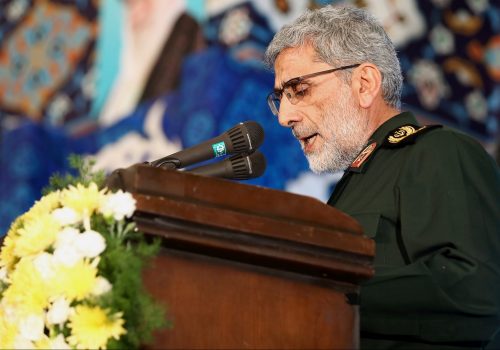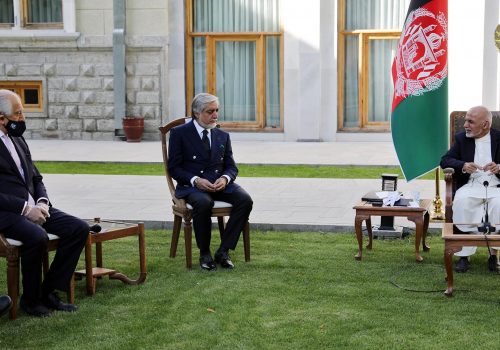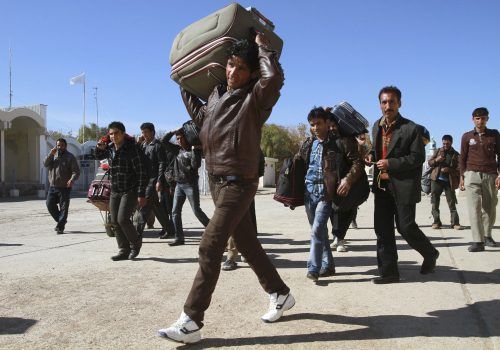Iran’s railway ambitions go beyond Afghanistan
The first railway between Iran and Afghanistan was launched in December 2020, linking the Iranian northeastern city of Khaf to Afghanistan’s western city of Ghoryan over a 140 km track. The project represents a major step toward increasing Afghan-Iran trade and opening landlocked Afghanistan to the rest of the world through the Iranian port of Chabahar.
Iran paid for the $75 million project as part of development assistance to Afghanistan following the overthrow of the Taliban regime in 2001. Once completed, the 225 km Khaf-Herat network would help transport six million tons of goods and up to a million passengers annually.
As part of a larger East-West Railway Corridor extending to China and Europe, the new railway track consists of four sections, three of which were funded and developed by Iran. The last section to Herat is about 80 percent done and is being financed by Italy.
Afghan President Ashraf Ghani described the railroad as “a precious gift from Iran” that would help restore the ancient Silk Road. Iranian President Hassan Rouhani hailed the launch as a “historic day” for both countries and described it as Afghanistan’s gateway to Europe, asserting that it would contribute to regional development, security, and stability.
Rouhani added that completion of the project, which began in 2007, is a clear indication of how Iran values the development of its neighbor despite Iran being under harsh economic conditions due to US sanctions.
While the first railroad in Afghanistan was constructed in 1907, decades of war and insecurity have resulted in serious underdevelopment of the country’s railway system in addition to roads and bridges. This has been a major disincentive to transport. Thus, the recently launched railway—the first with standard size track in Afghanistan—marks a major breakthrough for the entire region.
The Khaf-Herat railway was part of a bigger agreement among Iran, India, and Afghanistan to develop Iran’s southeastern port of Chabahar. India is jointly developing Chabahar as a reliable access route to Central Asia and a counter to the Gwadar Port in Pakistan, which is being developed by India’s rival, China.
Located on the Sea of Oman, Chabahar is part of the International North-South Transport Corridor (INSTC), a strategic trade route agreed among Iran, India, and Russia in 2000. When completed, the multi-modal corridor linking Asia and Europe will be 40 percent shorter and cost up to 30 percent less than current routes.
The new railway is the latest in a series of projects Iran has implemented, mostly in Afghanistan’s Western regions, as part of a $560 million pledge for rebuilding Afghanistan. Tehran was one of the largest donors at a 2002 Tokyo conference, pledging more than India, Saudi Arabia, the United Arab Emirates, Turkey, Norway, Switzerland, Australia, and Pakistan combined.
Schools, power plants, new border crossings and roads are some of the other projects Iran has undertaken. In 2005, Iran opened the 122 km Dogharun-Herat highway that has been serving as one of the main import-export gateways to Afghanistan. That $60 million project was built by Khatam-al Anbiya, the construction arm of the Islamic Revolutionary Guard Corps (IRGC), which has been on a US sanctions list since 2010.
While Iran’s major investments in Afghanistan’s western regions reflect strong historic and cultural ties between the two nations, the economic benefits are also significant, especially at a time when Iran is under heavy US sanctions reimposed by the Trump administration. Iran is currently Afghanistan’s largest trade partner followed by China and Pakistan.
Beyond economic and cultural aims, Iran wants to improve the security of its borders, create more jobs, and reduce poverty in the hopes of decreasing illegal immigration from Afghanistan. Iran also seeks to improve access to important raw materials, such as iron ore mines in western Afghanistan.
Instability and climate change have contributed to significant underdevelopment in Iran’s southeast provinces of Sistan and Baluchestan, Khorasan, Khorasan Razavi, and Kerman. Projects under construction, such as the Khaf-Herat railway and the Chabahar-Zahedan-Mashhad railway, should boost local economies.
Iran also sees these railways as a way to counter US sanctions and improve economic ties with its neighbors. Iran already has rail links with Turkmenistan, Pakistan, and Turkey and is expected to complete six more railway projects by the end of 2021. Ongoing projects will connect the railway network to Astra in Azerbaijan and Basra in southern Iraq.
Iran’s location makes it an ideal transit hub for landlocked Central Asia. Although it has so far become a member in numerous international corridors—including the International North–South Transport Corridor (INSTC), East West Transport Corridor (Ancient Silk Road), South Asia Corridor, and Transport Corridor of Europe Caucasus Asia (TRACECA)—US sanctions, the country’s controversial foreign intrusions, and local mismanagement have undermined Tehran’s potential. Some Iranian officials have warned that the country might be excluded from major international corridors by 2030 if its neighbors assess the risks as too high due to continued US sanctions, concern about Iranian foreign policies, or uncompetitive high tariffs. According to Tehran University’s Gholamheidar Ebrahim Bay Salami, the new railway also faces challenges from Pakistan, which seeks to play a similar transit role.
Meanwhile, Europe and the United States have long sought to promote the development of rail lines in the South Caucasus to bypass both Iran and Russia. Given the recent conflict over the Nagorno-Karabakh enclave and the opening of the Zengezur corridor across southern Armenia, Turkey has also announced plans to build a railway to Azerbaijan’s Nakhchivan, which would ultimately reach Baku.
According to a 2019 report by the Iranian parliamentary research center, Tehran’s transit ambitions can only be achieved if the renovation of old infrastructure, financing, and legislation are also addressed in parallel with foreign issues.
Maysam Bizaer is an analyst and commentator on Iran’s foreign policy, politics and economy. He is a frequent contributor to international media and US-based think tanks covering the Middle East. Follow him on Twitter @m_bizar.
Image: The first train departs Khaf's rail station in Iran during the inauguration of the Herat-Khaf railway operations connecting Iran and Afghanistan. via Reuters


